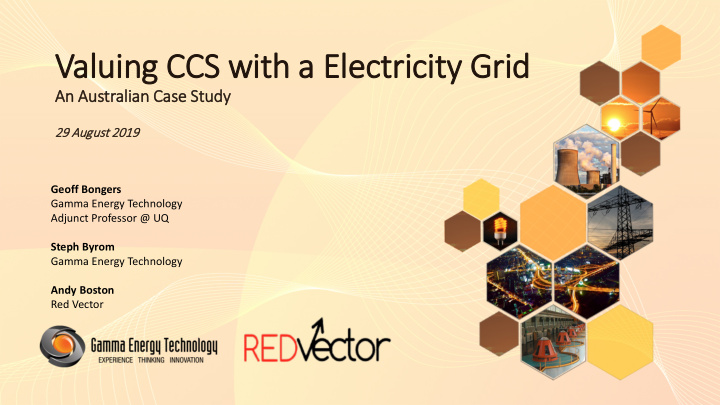



Click to edit Master title style Val aluing C g CCS wi with a a Elec ectricity G y Grid An A Australian C Case S e Study • Click to edit Master text styles 29 August 2019 29 2019 • Second level • Third level • Fourth level Geoff Bongers • Fifth level Gamma Energy Technology Adjunct Professor @ UQ Steph Byrom Gamma Energy Technology Andy Boston Red Vector
Levelised Cost of Electricity Click to edit Master title style LCOE • Click to edit Master text styles A simple metric designed to compare fossil plants, it takes no account of ‘the system.’ • Second level • Third level Assumption is that generation = MWh available • Fourth level LCOE = Variable Cost + (Fixed Cost + Annualised Capex) • Fifth level Annual Availability
Click to edit Master title style System Cost of Replacement Electricity SCoRE • Click to edit Master text styles SCoRE is similar to LCOE but takes account of the value of the technology to the system and its affect on • Second level system cost. It is designed to compare technology cost • Third level in a decarbonisation scenario. • Fourth level SCoRE is lower at low decarbonisation because takes • Fifth level into account of plant that can be retired when new plant is added (unabated coal in this case) Curtailment of renewables increasingly reduces its value at medium to high penetration SCoRE = Increase in Total System Cost due to New Plant Annual Generation of New Plant* Where TSC = Sum (variable + fixed + annualised capex) For all plant on the system TSC benefits from closure of old high carbon plant which is replaced by new technology (so long as system adequacy is not compromised.) Calculated for NEM, closing oldest coal where possible.
Click to edit Master title style LCOE vs SCoRE SCoRE is a metric intended to replace LCOE, but has its limitations compared to a full Total System Cost approach • Click to edit Master text styles • Second level Comparators Examples LCOE SCoRE TSC • Third level • Fourth level Thermal plant for Coal, gas, biomass Yes - ideal Yes - but overly Yes - but overly • Fifth level Baseload energy complex complex Inflexible thermal Nuclear No - deceptively Yes Yes plant high Variable renewables Wind, PV No - deceptively Yes Yes high Plant delivering grid Synchronous No - divide by zero No - divide by zero Yes services only condensers, standby error error Storage Batteries, pumped No - becomes No - becomes Yes hydro negative negative
Click to edit Master title style MEGS: Modelling Energy & Grid Services • Click to edit Master text styles – Energy must balance. Conservation of Energy • Second level • Third level Whilst minimising short run cost – There is sufficient supply of • Fourth level Fuel Managing imbalances • reserve and response • Fifth level Carbon Storage • services. Variable • Start-up • And optimising storage – There is sufficient inertia Stability: time to react – There is sufficient reliable Adjusts capacity to maintain Loss of Keeping the lights on! capacity to meet peak Load Hours demand
Click to edit Master title style THANKS For more details and information… • Click to edit Master text styles We are online: • Second level • Third level Twitter • Fourth level @GammaEnergyTech • Fifth level Facebook @GammaEnergyTech LinkedIn: gamma-energy-technology & red-vector WWW www.powerfactbook.com & redvector.co.uk
Recommend
More recommend